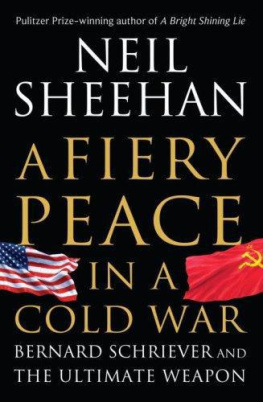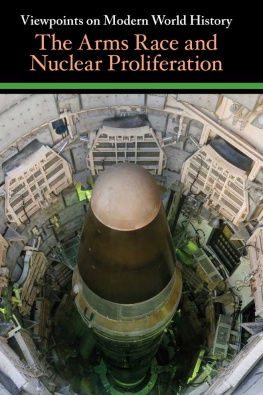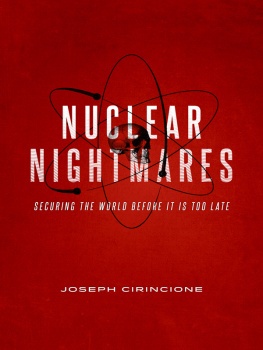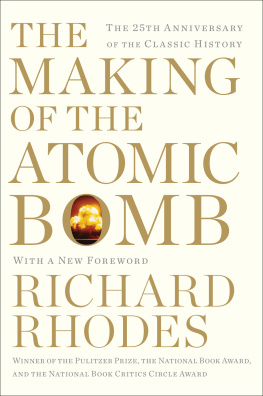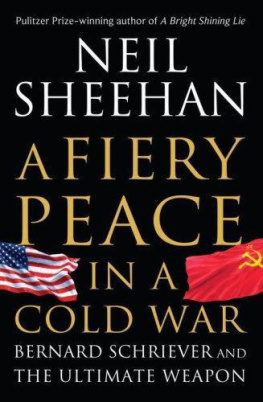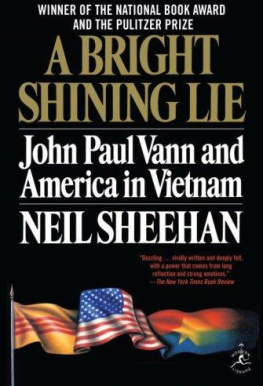For Susanwho else?
For Maria and Catherine
For Will
And for my grandson, Nicholas Sheehan Bruno
FOREWORD W hen the Space Age is mentioned, most people think of Sputnik, the launching into orbit of the first man-made satellite by the Soviet Union on October 4, 1957, or the race between Russia and the United States to land men on the moon. Sputnik was a psychological thunderclap. It set off a paroxysm of fear that the Soviet Union had gained a commanding technological lead over the United States. The moon landing by Neil Armstrong and Edwin Aldrin on July 20, 1969, was its reverse: a spectacular feat of American technology with little in the way of practical benefits. This book is concerned with a quite different space race. This other race initiated Americas exploration and exploitation of space and was for the highest stakespreventing the Soviet Union from acquiring an overwhelming nuclear superiority that could tempt Soviet leaders into international blackmail and adventurism with calamitous results for human civilization. Its outcome thus directly affected the security of the United States and the non-Communist nations of Europe, as well as the preservation of the fragile equilibrium between the two superpowers during the Cold War. The story of this other race, of the man who led it, an Air Force officer named Bernard Schriever, of those who labored with him, of the times in which they grew up and came of age and the challenges and obstacles they had to overcome, forms the narrative of this book.
CONTENTS
BOOK I 
10.
BOOK II 
20.
BOOK III 
28.
BOOK IV 
36.
BOOK V 
48.
BOOK VI 
68.
BOOK VII 
78.
EPILOGUE 
83.
PROLOGUE:
A Rite of Succession G eneral Henry Harley Arnold, known as Hap because of his unusual smile, was in a hurry in January 1946. During the Second World War, which had ended the previous August with the surrender of Japan, he had created and led the greatest air armada ever assembled, the U.S. Army Air Forces. The stress of the war had exacted a toll on a fragile heart. He had suffered two heart attacks during the war and a third shortly after its conclusion. (He was to die of heart failure on January 15, 1950, at the age of just sixty-three.) He knew he would have to retire soon and turn command of his Army Air Forces over to his trusted friend and second man, Carl Tooey Spaatz. While the outcome of the war was still in doubt, Arnold had, with a couple of exceptions, held innovation to what was practical and could be committed rapidly to combat. The one entirely new aircraft he had decided to build and nurtured to completion during the conflict was the B-29 Superfortress, because it had been necessary for the long-range strategic bombing campaign against Japan. Not that he had neglected to avail himself earlier of civilian scientific talent whenever he thought that it could help him solve particular problems. Back in 1939 with the conflict in Europe just beginning, he had invited General George Marshall, then the new chief of staff and a friend of Arnold Army since they were lieutenants together in the Philippines prior to the First World War, to join him at lunch with a group of scientists with whom he was conferring. Marshall was a believer in the efficacy of air power, but respect born of the friendship was another reason he was to treat Arnold, officially subordinate to him, as an equal. During the war he made him a member of the Joint Chiefs of Staff and allowed him to organize the Army Air Forces with an autonomy that would prepare the way for postwar independence. Marshall was, however, an infantryman by profession. He was not accustomed to the company of long hairs, as the regular military pejoratively referred to the scientific community. What on earth are you doing with people like that? he asked Arnold afterward. Arnold explained that he was using their original minds to create instruments for our airplanes that are far too difficult for the Air Force engineers to develop themselves. As 1944 wore on, with the defeat of Hitlers Third Reich not long off and Imperial Japans demise certain to follow, Arnold could afford to look ahead and set free the evangelist of technology that dwelt within him. He intended to leave to his beloved air arm a heritage of science and technology so deeply imbued in the institution that the weapons it would fight with would always be the best the state of the art could provide and those on its drawing boards would be prodigies of futuristic thought. Above all, he was determined to avoid a return in the postwar period to those disheartening years of the early 1930s when, as he put it in a letter to another old friend, Dr. Robert Millikan, president of the California Institute of Technology, just a relatively small group of enthusiastic officers [were] struggling against ignorance and indifference as to the importance of aviation and air power to the security and the very existence of the nation. Apparently with the Soviet Union in mind, he was also convinced that the downfall of Germany and Japan did not mean an enduring peace. It was axiomatic, he wrote, that because the United States would emerge from the conflict as one of the predominant powers we will no doubt have potential enemies that will constitute a continuing threat to the nation. The Second World War had also wrought a change in the military cosmos as transforming as the one it was bringing about in the geopolitical universe. The nation could no longer look to the seas as the protective barrier around it, nor to the U.S. Navy as the bulwark to stop an enemy from breaching that barrier. The air was now the space that mattered and the safety of the nation depended upon the ability of the U.S. Army Air Forces, soon to become the independent U.S. Air Force, to reign supreme in the skies. Hiroshima was also to make the new air arm first among equals where the other services were concerned, because it could deliver that most cataclysmic of weaponsthe atomic bomb. Ever since the early fall of 1944, Arnold had been commissioning studies and funding experimental weaponry. Now, with his retirement impending and his preparations for the future nearing completion, Arnold summoned to his Pentagon office a young colonel named Bernard Schriever. Bennie Schriever had grown up in San Antonio, Texas, and acquired his nickname from the sportswriters there. He had been a champion amateur golfer as a youth and they had wanted a snappy moniker for their articles about his exploits on the links. They had dubbed him Benny, and the nickname had stuck during his military years but had acquired the somewhat inelegant spelling above. Schriever had spent the war out in the Pacific and had reported to the Research and Engineering Division of the Air Staff only a few days before. When he was told that Arnold wanted to see him as soon as possible, he hurried over to the River Entrance on the outer, or E Ring, corridor of the Pentagon overlooking the Potomac, where the high panjandrums like the general had their domain. After the usual wait in the outer office in which the aides and secretaries worked, he was shown into the ample inner one, where Hap Arnold sat behind a large desk. Each of the shoulder tabs of his olive drab uniform jacket held a ringlet of five silver stars, General of the Army, the highest rank to which an officer could aspire. Arnold was the only airman ever to achieve it. He beckoned Bennie to one of the easy chairs in front. What ensued was the classic passing on by an older man of the final mission of his life and career to a young disciple. There would come a day, Arnold told Schriever, when scientists and scientifically trained officers would be just as important to the Air Force as the operators who currently ran it, AAF parlance for the men who had risen to general officer commands by their ability to wield bomber and fighter forces in combat. Nurturing the process that would lead to this day was crucial because of the difference it would make in the potency of American air power. To emphasize his point, the general stressed to Schriever the same parting message he was leaving with Spaatz and others: it was the civilian scientists, not the military engineers, who had been the technological innovators during the war. They are the ones who made the breakthroughs, he said. He predicted that those breakthroughsin radar, in jet propulsion, in rocketry, in nuclear weaponswould prove to be the catalysts for further innovation that would radically alter the nature of war. The First World War had been decided by brawn, he said, the Second by logistics. The Third World War will be different. It will be won by brains. There was no need for him to mention Joseph Stalins Soviet Union as the threat. Both men understood it. All of us, at least those of us in the military, thought that we were in for a long siege with Communism, Schriever was to say years later in recounting the meeting. The rub was that with the end of the war, the scientists responsible for these accomplishments were returning to their universities. The laboratories at which they had worked were either shutting down, like the Radiation Laboratory at MIT, or being drastically shrunk, as at Los Alamos, where the atomic bomb had been created. To try to preserve the relationship with these scientists, Arnold was ordering the formation of a new Scientific Liaison Branch within the Research and Engineering Division. He wanted Schriever to head it. Schrievers task would be to provide staff backup for projects civilian scientists undertook at the behest of the AAF. He was also to help with similar staffing in the establishment of a new network of research and testing centers for which Arnold had laid out plans, and to contribute to any other opportunities that arose to draft science and technology into air powers service. Had the officer sitting across the desk from Arnold been of more ordinary mind-set, the job he was being given would have been an interesting but hardly inspiring one. Perhaps Arnold sensed that Bernard Schriever was different and that was why he had sent for him. Perhaps he sensed it from their long relationship, which went back to the 1930s, or from the postgraduate degree Schriever had gained in aeronautical engineering; or from his stellar performance as an engineer officer in the Pacific; or from the fact that he had asked for research and development as a postwar assignment. Whatever his reasons, Arnold had summoned the right man. Schriever had the intellectual bent and the foresight to see the implications for the future that Arnold saw. He also shared Arnolds vision. And there was more to it than that. There was a chemistry between the two men. Arnold had been his first chief when Schriever had been a novice second lieutenant pilot at March Field near Riverside, California, in 1933, fresh from the Flying School at Kelly Field next to San Antonio. Arnold had been the man who had later rescued him from the humdrum of an airline pilots life and set him forth on the surpassing adventure of the Second World War. Arnold had been the leader who had fought so hard and so well to transform their ludicrously antique biplane Air Corps of the 1930s into an invincible host of the skies. In one of the last acts of his career, this man of whom Schriever stood in awe was appointing him to a task that Schriever knew meant more to Arnold than any other. Bennie Schriever said goodbye and left Arnolds office not just as an airman with an assignment. He left as an apostle with a calling. What he would accomplish in the years to come he would do for himself, but in his mind he would also be doing it because Hap Arnold had entrusted him with the mission. He would not fail his chief. He would go on to become the father of the modern, high-technology Air Force and play a pivotal role in preserving peace during the grim years of the Cold War by building the first weapon in the history of warfare that was meant to deter rather than to be fired in angerthe intercontinental ballistic missile.

